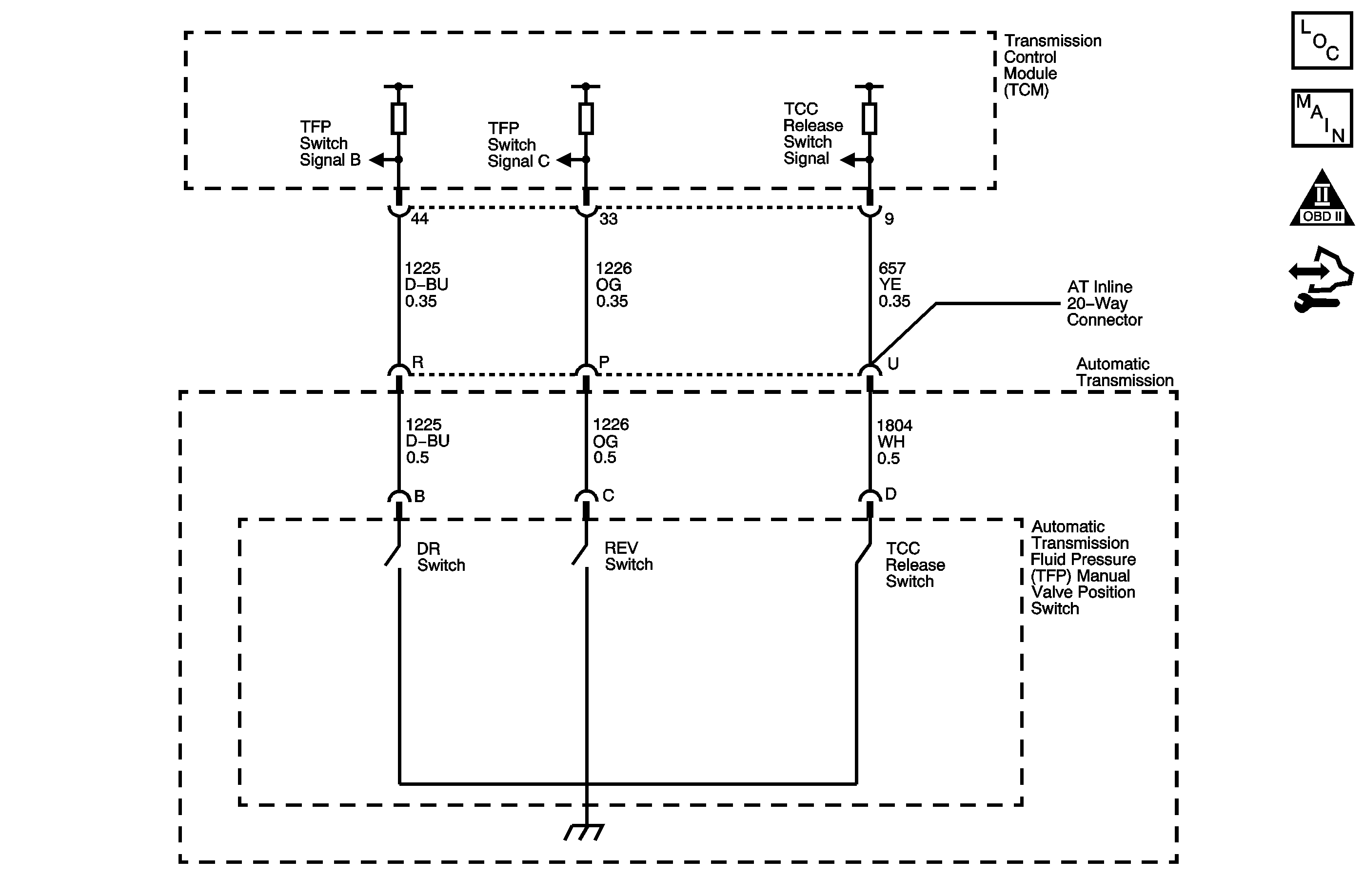
Circuit Description
The torque converter clutch (TCC) release switch is part of the automatic transmission fluid pressure (TFP) manual valve position switch. The TFP manual valve position switch is attached to the control valve body. The TCC release switch is normally-closed.
The switch signals the transmission control module (TCM) that the TCC is released. This is accomplished by torque converter release fluid pressure acting on the switch contact, thus opening the switch. When the voltage is high on the circuit, the TCM recognizes that the TCC is no longer engaged.
When the TCM determines that the TCC release switch is open, indicating that the TCC is not applied, and the TCC slip speed indicates that the TCC is applied, then DTC P0843 sets. DTC P0843 is a type B DTC.
DTC Descriptor
This diagnostic procedure supports the following DTC:
DTC P0843 Transmission Fluid Pressure (TFP) Sensor Circuit High Voltage
Conditions for Running the DTC
| • | No MAP DTCs P0107 or P0108. |
| • | No ISS DTCs P0716 or P0717. |
| • | No TCC performance DTCs P0741 or P0742. |
| • | No TCC electrical DTCs P2763 or P2764. |
| • | The engine is running for 5 seconds. |
| • | The transmission fluid temperature (TFT) is 20-130°C (68-266°F). |
| • | The engine torque is greater than 50 N·m (37 lb ft). |
| • | The TCC is commanded ON. |
| • | The TCC slip speed is -20 to +60 RPM. |
Conditions for Setting the DTC
The TCC release switch is open, release fluid pressure present, for 6 seconds, twice during the same trip.
Action Taken When the DTC Sets
| • | The TCM illuminates the malfunction indicator lamp (MIL) during the second consecutive trip in which the Conditions for Setting the DTC are met. |
| • | The TCM forces the TCC OFF. |
| • | The TCM inhibits TCC engagement. |
| • | The TCM freezes transmission adaptive functions. |
| • | The TCM inhibits 4th gear when in HOT mode. |
| • | The TCM records the operating conditions when the Conditions for Setting the DTC are met. The TCM stores this information as Freeze Frame and Failure Records. |
| • | The TCM stores DTC P0843 in TCM history during the second consecutive trip in which the Conditions for Setting the DTC are met. |
Conditions for Clearing the MIL/DTC
| • | The TCM turns OFF the MIL during the third consecutive trip in which the diagnostic test runs and passes. |
| • | A scan tool can clear the MIL/DTC. |
| • | The TCM clears the DTC from TCM history if the vehicle completes 40 warm-up cycles without an emission related diagnostic fault occurring. |
| • | The TCM cancels the DTC default actions when the ignition switch is OFF long enough in order to power down the TCM. |
Diagnostic Aids
Ensure the wiring harness is not stretched too tightly or other components are pressing on the connector body. Also, inspect for proper clearance to any other components and wiring. Refer to Testing for Intermittent Conditions and Poor Connections .
Test Description
The numbers below refer to the step numbers on the diagnostic table.
-
This step tests the ability of the TCM to recognize a grounded circuit.
-
This step tests for a mechanical or hydraulic condition.
Step | Action | Yes | No | ||||||||||||||||||||||||||||||||||
|---|---|---|---|---|---|---|---|---|---|---|---|---|---|---|---|---|---|---|---|---|---|---|---|---|---|---|---|---|---|---|---|---|---|---|---|---|---|
1 | Did you perform the Diagnostic System Check - Vehicle? | Go to Step 2 | |||||||||||||||||||||||||||||||||||
2 |
Important: Before clearing the DTC, use the scan tool in order to record the Freeze Frame and Failure Records. Using the Clear Info function erases the Freeze Frame and Failure Records from the TCM. Does the scan tool indicate TCC release pressure is present? | Go to Step 3 | Go to Step 6 | ||||||||||||||||||||||||||||||||||
Does the scan tool indicate TCC release pressure is present? | Go to Step 4 | Go to Step 5 | |||||||||||||||||||||||||||||||||||
4 | Test the signal circuit of the TCC release switch for an open between the TCM connector and the AT inline 20-way connector. Refer to Testing for Continuity and Wiring Repairs . Did you find and correct the condition? | Go to Step 11 | Go to Step 10 | ||||||||||||||||||||||||||||||||||
5 | Test the signal circuit of the TCC release switch for an open between the AT inline 20-way connector and the TFP manual valve position switch. Refer to Testing for Continuity . Did you find the condition? | Go to Step 8 | Go to Step 9 | ||||||||||||||||||||||||||||||||||
6 |
With the TCC applied and slip speed less than 60 RPM does the scan tool indicate TCC release pressure is present? | Go to Step 7 | Go to Testing for Intermittent Conditions and Poor Connections | ||||||||||||||||||||||||||||||||||
Did you complete the repair? | Go to Step 11 | -- | |||||||||||||||||||||||||||||||||||
8 | Replace the automatic transmission wiring harness. Refer to Wiring Harness Replacement . Did you complete the repair? | Go to Step 11 | -- | ||||||||||||||||||||||||||||||||||
9 | Replace the TFP manual valve position switch. Refer to Transmission Fluid Pressure Manual Valve Position Switch Replacement . Did you complete the repair? | Go to Step 11 | -- | ||||||||||||||||||||||||||||||||||
10 | Replace the TCM. Refer to Control Module References for replacement, setup, and programming. Did you complete the replacement? | Go to Step 11 | -- | ||||||||||||||||||||||||||||||||||
11 | Perform the following procedure in order to verify the repair:
Has the test run and passed? | Go to Step 12 | Go to Step 2 | ||||||||||||||||||||||||||||||||||
12 | With the scan tool, observe the stored information, capture info and DTC info. Does the scan tool display any DTCs that you have not diagnosed? | System OK |
